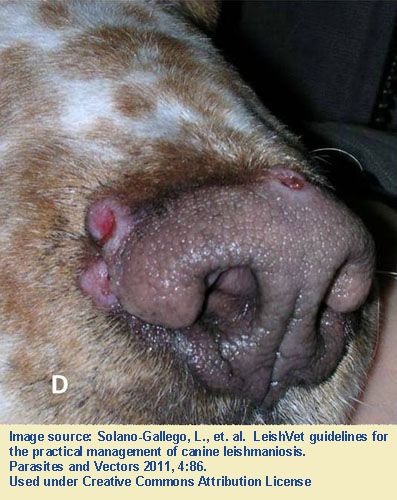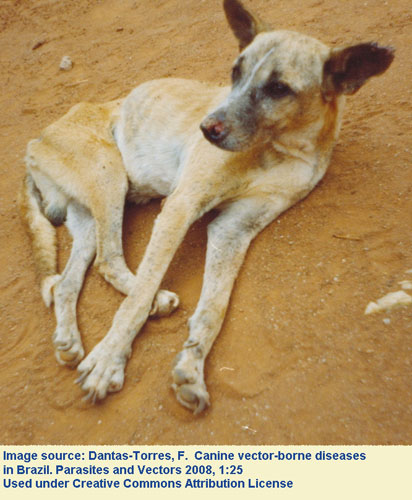Leishmania species
Species of the flagellate protozoan Leishmania infect people, domestic dogs and an array of free-ranging mammals in South and Central America, southern Europe, the Middle East, Africa, Asia, and most recently dogs in North America.
Overview
Species of the haemoflagellate protozoan Leishmania infect people, domestic dogs and an array of free-ranging mammals in South and Central America, southern Europe, the Middle East, Africa, Asia, and most recently foxhounds in North America. The life cycle of Leishmania is usually indirect, involving sand fly intermediate hosts (vectors). The blood-feeding activities of the nymph and adult flies transmit the parasite among its mammalian hosts. In southern Europe and in other regions of the world, domestic dogs and free-ranging canids are important reservoir hosts for human infections with Leishmania. Many people and animals infected with the parasite may not show any clinical signs, but disease in people is of three types: visceral, cutaneous; and muco-cutaneous. Visceral and cutaneous leishmaniasis are also seen in dogs. Signs, if they develop, may occur months to years after infection and include hair loss, weight loss, diarrhea, nose bleeds, conjunctivitis, lymphadenopathy, lameness, and others depending on the organs affected.
Until the late 1990s leishmaniasis in dogs in North America was considered an exotic disease, with most or all infections acquired in endemic areas elsewhere in the world. Since 1999, however, L. infantum has been reported in foxhound kennels in many eastern and south-eastern states (not including Florida and most of New England), as well as in Ontario and Nova Scotia. Transmission is thought to occur primarily via direct contact, for example by bite wounds, or transplacentally . Diagnosis should consider breed (foxhound?), travel history (travel to tropics or Mediterranean?) and clinical signs, and is confirmed by serology or culture/PCR of parasites from biopsies. Treatment of Leishmania is difficult because of a lack of effective drugs and problems with drug toxicity. Although pentavalent antimonials, allopurinol, and miltefosine have been tried, they are difficult and expensive to acquire, and no drug is considered curative. Owners taking their dogs with them to endemic regions should be aware of the risk and minimize exposure of dogs to sandflies by housing dogs indoors, especially at times of day when sandflies are most active.

Nodular crateriform lesions bordering the muzzle

Canine visceral leishmaniasis
References
Petersen CA et al. (2009) Canine leishmaniasis in North America: emerging or newly recognized. Veterinary Clinics of North America Small Animal Practice 39: 1065-1074.
Petersen CA (2009) Leishmaniasis, an emerging disease found in companion animals in the United States. Topics in Companion Animal Medicine 24: 182-188.
Duprey ZH et al. (2006) Canine visceral leishmaniasis, United States and Canada, 2000-2003. Emerging Infectious Diseases 12: 440-446.
Gaskin AA et al. (2002) Visceral leishmaniasis in a New York foxhound Kennel. Journal of Veterinary Internal Medicine 16: 34-44.
https://research-groups.usask.ca/cpep/parasites/protozoa-supplementary.php
https://research-groups.usask.ca/cpep/research/imported-pets.php

